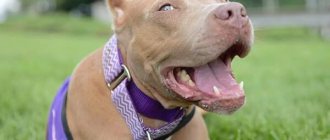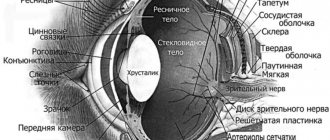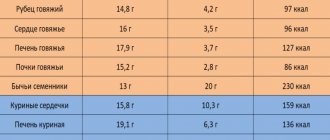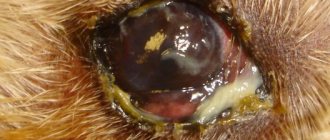How does vision work in dogs?
Scientific research shows that dogs have vision differently than humans. They have color vision, although they see fewer colors (in particular, they do not see red, orange, yellow and some other shades). They also have a different viewing angle and image clarity - but, on the other hand, they can see in the dark. All these differences are due to the fact that the structure of their eyes is slightly different, and all the main differences appeared due to the fact that dogs went through a different evolutionary path.
Dog's Field of View
First, let's look at how dogs see horizons, or more precisely, how wide their field of vision is. This aspect primarily depends on how the animal’s eyes are set, so we can immediately note that different breeds will have completely different vision. The location of the eyes determines the binocular field, as well as the lateral areas that vision captures. Thus, the overall panorama of how dogs see the horizon is 240-260 degrees, of which only 30-60 is the binocular field (a person’s field of view is 200 degrees, binocular vision is 140). Don't forget that a dog's long nose can also interfere with vision. As for animals with short noses, in most cases their eyes are set even further apart, which makes their binocular field smaller. Ears or long hair can interfere with a dog’s inspection of anything else.
How does a dog see?
Now let's take a closer look at the main differences in vision in dogs.
Features of dog vision
Main features:
- The eyes of animals are set wider than those of humans, so their lateral vision is more developed. At the same time, vision itself is less clear, and animals see moving objects blurred.
- Visual information comes from two eyes, which read information separately. The combination of the received information is carried out in the brain, and the animal sees the whole picture.
- Canines do not have a central fossa like humans. Therefore, they are better at distinguishing objects at medium and long distances, and they do not need to move their eyes to identify objects.
In nature, canids are carnivores that can eat some plant foods when food is scarce. Therefore, viewing range and the ability to quickly determine the distance to an object are important to them. Clarity of vision and color are not of serious importance for them, since these signs do not contribute to survival.
Are dogs nearsighted or not?
Dogs do not have myopia, but they can distinguish distant objects better. To distinguish an object, there must be a distance of at least 30 centimeters between the eye and the animal (otherwise they will not be able to focus their vision). In many dogs in old age (when they are over 10 years old), the functioning of the eye muscles deteriorates, which can lead to myopia. However, such myopia is more associated with old age than with the structure of the visual system.
How dogs determine distance
Research shows that dogs are more accurate in determining the distance to objects. Scientists do not know the exact mechanism of this phenomenon, but there are several hypotheses that are related to the characteristics of rod photoreceptors:
- Higher sensitivity of rods. In the wild, dogs are predators, so evolution favored the survival of canids whose cones were more sensitive.
- Extra sticks. A person's eye has an area of the macula where rods are absent. Dogs do not have a yellow spot, so the sticks are located there.
How far can dogs see?
The viewing range depends not only on the distance, but also on the method of movement of the object. The animal sees stationary objects at a distance of 600 meters. If an object moves, then the animal can see it at a distance of up to 800-900 meters. This effect is due to the fact that canines have more rods, which are responsible for distinguishing objects. For this reason, zoologists do not recommend running from dogs - the animals will immediately see and rush at you.
Field of vision of a dog's eye
It is stretched to the sides, which is due to the wider set of the eyes. The dog's visual angle is 250 degrees, and one eye has a field of view of 150 degrees. Animals see best at objects that are located within 60 degrees, where both eyes overlap each other. Lateral vision is well developed, but moving objects are blurry.
Attention! A person’s viewing sector is 170 degrees, and each eye “gives” a viewing angle of 140 degrees.
Clarity, Sharpness, Contrast
In dogs, the clarity, sharpness and contrast of visual perception is much worse than in humans. Imagine a slightly blurry photograph of mediocre quality, when the photographer’s hand trembled a little in the moment before taking the picture - this is exactly how animals see our world. However, the low clarity is compensated by a developed sense of smell, which allows dogs to lead a full life.
How they see in the dark
Animals see the outlines of objects well in the dark, so at night they can move and even hunt. Night vision is associated with the presence of a tapetum, which is the name given to a special layer of cells in the fundus of the eye that can reflect external light. Thanks to this, the light from external sources is enhanced, and the canines acquire the ability to distinguish objects in the dark.
Features of the visual organs of some breeds
In general, dogs are predators, so in general terms the specifics of their visual perception of the world are the same, regardless of breed. Although some features are still revealed. The ability to perceive a panoramic picture of the surrounding world is inherent in all breeds. But dogs with a long nose and narrowed muzzle have a greater degree of visual latitude.
Representatives of some breeds have a short nose and a wide skull. This is why they have very poor peripheral vision. We are talking about:
- pugs;
- Pekingese;
- bulldogs.
For your information! Some researchers believe that the vision of wild animals is sharper than that of domestic pets. Evidence has not yet been received, but statistics show that all inhabitants of the wild have more developed senses than those tamed by people.
What colors do dogs see?
Previously, scientists believed that dogs see the world in black and white, but this hypothesis was rejected. Today it is believed that dogs have color vision, but they cannot distinguish between green, yellow, orange, and red shades. This is due to the fact that dogs do not have cones, which are responsible for the color red. But dogs can clearly distinguish the colors of the blue and violet spectrum, and also distinguish more than 30 shades of gray.
Attention! If a dog looks at an object of a “forbidden” color, it will be colored white or gray.
Definition
According to this indicator, dogs are inferior to people; they see the world blurry and unclear. Small objects merge before their eyes into amorphous spots, painted in different tones. At the same time, dynamic objects are perceived by animals much more clearly than stationary ones.
Note! The movement of an object helps dogs navigate. Therefore, when an animal is aggressive, you can freeze, since a static object is practically invisible to it.
Hypothetically, when checking acuity on an ophthalmic chart, the dog would only be able to see the third line.
For dogs there are no red and green tones, they merge into gray tones
Differences in perception between humans and dogs
The main differences in perception are presented in the table:
| Parameter | People | Dogs |
| Chroma | Available in colors ranging from red to purple | Distinguish colors from dark green to purple, see more than 30 shades of gray |
| Range of vision with good discrimination of objects | 1-2 km | 900 meters |
| Viewing angle | 170 degrees | 250 degrees |
| Definition | High | Average |
| Optical Flux Density | See both close and distant objects well | See distant objects better |
| Recognizing objects that are not moving | Excellent | Bad |
| Vision in the dark | Absent | Eat |
Attention! The data in the table for animals and humans are averaged. In reality, the quality of vision may differ from age, lifestyle, quality of food and other parameters.
Vision problems
Canines can have many vision problems - let's look at them, and also find out methods of treatment and prevention.
Why do vision problems occur?
After birth, puppies' eyes open at 10-14 days of life, but good vision does not appear immediately. Research shows that puppies begin to perceive the world well at the age of 1-3 months, depending on the breed. Eye problems in young and adult individuals arise for the following reasons:
- Mechanical injuries. Problems with the visual system often arise due to mechanical injuries. Twigs, pebbles, other animals and even favorite toys act as traumatic objects.
- Lack of vitamins. For the normal functioning of the eyes, animals need to absorb vitamins C, E, A and some others from food. If there are not enough of them, the dogs will see worse.
- Eye contamination. During a walk, animals' eyes and fur around the eyes can become clogged with dust and small particles of debris. They cannot get rid of such garbage on their own.
How to warn them
Basic recommendations:
- Feed your animal correctly. The diet should contain not only proteins, fats, carbohydrates, but also vitamins and minerals. Therefore, check the quality of the food or include mineral/vitamin supplements separately in the diet.
- Watch what the animal is playing with. Your favorite toys should not have sharp edges that could cause injury. Never allow fights with other animals.
- Wash your eyes after walks and trim the hair around your eyes. Dust and debris will not accumulate around the eyes, which will help avoid visual problems.
Prevention and treatment
To prevent disease, it is recommended to periodically take the animal to a veterinarian for a general examination. If an animal's vision suddenly deteriorates, then it is imperative to go to the veterinarian. Self-treatment of animals is contraindicated, since traditional methods and pharmaceutical drugs against such diseases are ineffective. And some medications can be harmful, so it's better not to take risks.
Useful tips
Let's look at some useful tips for keeping dogs that will help avoid eye problems:
- Walk your pet often to keep it healthy and strong. Sitting on the sofa negatively affects the functioning of the hormonal system, which worsens the well-being and health of the animal. However, avoid conflicts on the street to avoid mechanical eye injury.
- It is recommended to take your dog for a preventive examination 1-2 times a year. If the animal is sick, you must go to the doctor without fail. Some diseases are not dangerous, but they still need to be treated, since they can cause complications in internal organs, including the eyes.
In conclusion, we note that the quality of vision also depends on the breed. Small dogs usually have less acute vision, but age-related problems do not appear until much later. Large breed dogs are more aggressive, so they are more likely to get into conflicts with other animals, which can lead to eye injury.
conclusions
It is necessary to rinse both eyes, even if the discharge is observed in only one eye. The most effective method is combined washing. Eye canals and nasal mucosa of a dog.
In any case, the most basic rule that an owner should follow when detecting any symptom of a dog’s eye disease is to consult a specialist. Only a veterinarian can correctly diagnose your pet. Prescribe the correct treatment, and, if necessary, perform cosmetic surgery. And then your dog’s vision will be sharp.











